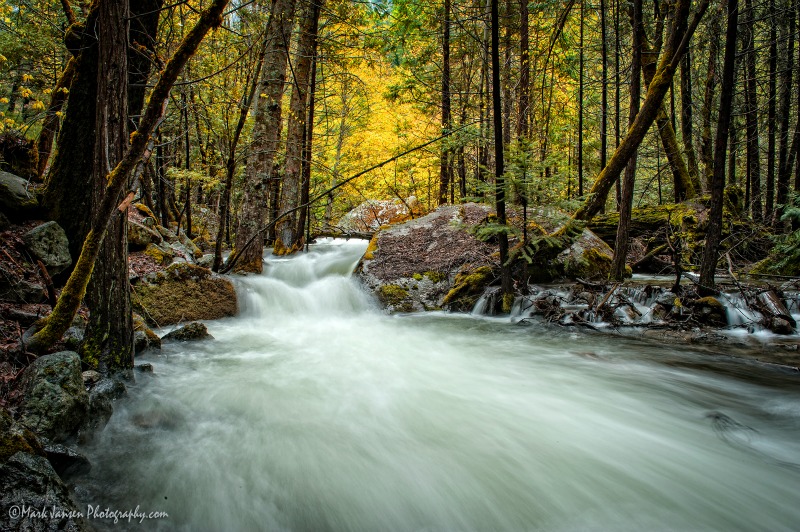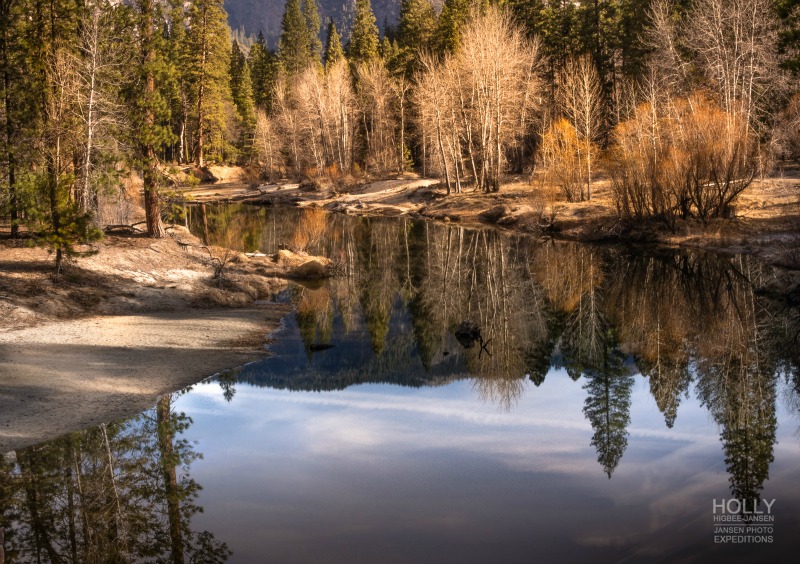As time to head north for Samy's Photo School's Yosemite National Park, Fall Exploration Workshop grows near,our team is getting increasingly excited about the opportunity.
The dates during which the photography workshop is being held - October 29th to November 1st - is an ideal time of the year for anybody looking for the chance to photograph the sort of autumnal beauty that is unique to the Yosemite Valley. Combine that with the expert knowledge that will be on hand from the workshop's instructors, Mark and Holly Higbee-Jansen of Jansen Photo Expeditions, and this truly is a nature photography experience none of us want to miss.
If you haven't booked your place on the workshop yet you can do it here!
 Since it is almost time to pack our bags for the journey, we thought it would be fun to ask Mark and Holly for their list of 'must-haves' for fall photo exhibitions. A great read not just for students joining Samy's Photo School on the Yosemite National Park Fall Exploration Workshop but for any photographer heading out on their own fall photography adventures.
Mark and Holly Jansen's Fall Photography Workshop Must-Haves
Memory Cards: Having a good supply of memory cards is essential for any workshop. Nobody wants to have to stop taking photos just because they ran out of space to store them.
Wide angle lens 14mm to 24mm: Locations such as the Yosemite Valley have varied opportunities for the wide landscape capture. A lens in this range will provide ample coverage.
Telephoto 100-200mm: Having a telephoto lens in this range, if not a bit longer,perhaps even 300mm comes in handy when the opportunity arises to photograph wildlife. The Yosemite Valley in particular is the home to many deer and the ample meadows may even allow for a chance to capture coyotes as they pounces on moles.
Hot Shoe bubble level: If your camera doesn’t have one built in, this simple device comes in handy. Hot Shoe bubble levels are readily available and fit snuggly in your camera's flash hot shoe.
Polarizer Filter: Great for cutting glare on water, but also helps with reflective glare on autumn leaves. They also assist in enhancing those beautiful fall colors.
Soft lined ND 9 Graduated Filter, and full (Solid) ND 9 Graduated Filter: With extreme exposure variation in deep valley environments, such as Yosemite, a 3 stop ND or neutral density filter helps with wide variances in light to dark exposures.
Solid, or fully shaded ND 9 3 stop filters: These help to provide a way to hold back light without over exposing your camera’s image sensor. Allowing for a for a silky flowing water effect, they will come in particularly handy when encountering flowing water. The filters are available in round or square. Square ones are suggested for the soft line graduated and a round one for the solid.
Battery charger and 4 or more fully charged batteries: You can never have enough batteries on a photography workshop. Marking each battery one with a number helps to keep track of your charging order.
Shutter cable release: An essential tool for a sharp exposure when using your DSLR’ mirror lock-up feature. A shutter cable release keeps your hands off your camera during your exposure time and helps to avoid camera shake. It also works well when using a mirrorless camera for spot on shots when not using a timer.
Since it is almost time to pack our bags for the journey, we thought it would be fun to ask Mark and Holly for their list of 'must-haves' for fall photo exhibitions. A great read not just for students joining Samy's Photo School on the Yosemite National Park Fall Exploration Workshop but for any photographer heading out on their own fall photography adventures.
Mark and Holly Jansen's Fall Photography Workshop Must-Haves
Memory Cards: Having a good supply of memory cards is essential for any workshop. Nobody wants to have to stop taking photos just because they ran out of space to store them.
Wide angle lens 14mm to 24mm: Locations such as the Yosemite Valley have varied opportunities for the wide landscape capture. A lens in this range will provide ample coverage.
Telephoto 100-200mm: Having a telephoto lens in this range, if not a bit longer,perhaps even 300mm comes in handy when the opportunity arises to photograph wildlife. The Yosemite Valley in particular is the home to many deer and the ample meadows may even allow for a chance to capture coyotes as they pounces on moles.
Hot Shoe bubble level: If your camera doesn’t have one built in, this simple device comes in handy. Hot Shoe bubble levels are readily available and fit snuggly in your camera's flash hot shoe.
Polarizer Filter: Great for cutting glare on water, but also helps with reflective glare on autumn leaves. They also assist in enhancing those beautiful fall colors.
Soft lined ND 9 Graduated Filter, and full (Solid) ND 9 Graduated Filter: With extreme exposure variation in deep valley environments, such as Yosemite, a 3 stop ND or neutral density filter helps with wide variances in light to dark exposures.
Solid, or fully shaded ND 9 3 stop filters: These help to provide a way to hold back light without over exposing your camera’s image sensor. Allowing for a for a silky flowing water effect, they will come in particularly handy when encountering flowing water. The filters are available in round or square. Square ones are suggested for the soft line graduated and a round one for the solid.
Battery charger and 4 or more fully charged batteries: You can never have enough batteries on a photography workshop. Marking each battery one with a number helps to keep track of your charging order.
Shutter cable release: An essential tool for a sharp exposure when using your DSLR’ mirror lock-up feature. A shutter cable release keeps your hands off your camera during your exposure time and helps to avoid camera shake. It also works well when using a mirrorless camera for spot on shots when not using a timer.
 Good sturdy tripod with slotted ball head and/or “L” bracket: The “L” Bracket is not necessary, but convenient for quick horizontal to vertical camera changes. Stay away from budget tripods if you can. You might go though many cameras over your photographic life, but you might have the same tripod forever. Spend a little more now and purchase a good solid tripod that's simple to operate. There are many good lightweight options. If you can’t afford a higher end carbon fiber mode, select a higher end well known aluminum model. You won't be disappointed and need to re-purchase it again by saving a buck or two with a cheap one!
Small headlamp with fresh batteries: This is an essential addition to any kit not only for early morning or late evening shoots but for light painting opportunities as well!
Small collapsible travel umbrella: You never know what can happen when you’re out in mother nature. They also make for great defusers for any macro photography opportunities
A couple of small and large Zip-Loc bags: Great for camera body protection. They also have more form fitting options available at camera stores.
Smart Phone or compact digital camera or back-up DSLR body (Just for backup):Never go on an important shoot without backup. The smart phone can be used as a GPS locator for your images too.
Good sturdy tripod with slotted ball head and/or “L” bracket: The “L” Bracket is not necessary, but convenient for quick horizontal to vertical camera changes. Stay away from budget tripods if you can. You might go though many cameras over your photographic life, but you might have the same tripod forever. Spend a little more now and purchase a good solid tripod that's simple to operate. There are many good lightweight options. If you can’t afford a higher end carbon fiber mode, select a higher end well known aluminum model. You won't be disappointed and need to re-purchase it again by saving a buck or two with a cheap one!
Small headlamp with fresh batteries: This is an essential addition to any kit not only for early morning or late evening shoots but for light painting opportunities as well!
Small collapsible travel umbrella: You never know what can happen when you’re out in mother nature. They also make for great defusers for any macro photography opportunities
A couple of small and large Zip-Loc bags: Great for camera body protection. They also have more form fitting options available at camera stores.
Smart Phone or compact digital camera or back-up DSLR body (Just for backup):Never go on an important shoot without backup. The smart phone can be used as a GPS locator for your images too.
 Since it is almost time to pack our bags for the journey, we thought it would be fun to ask Mark and Holly for their list of 'must-haves' for fall photo exhibitions. A great read not just for students joining Samy's Photo School on the Yosemite National Park Fall Exploration Workshop but for any photographer heading out on their own fall photography adventures.
Mark and Holly Jansen's Fall Photography Workshop Must-Haves
Memory Cards: Having a good supply of memory cards is essential for any workshop. Nobody wants to have to stop taking photos just because they ran out of space to store them.
Wide angle lens 14mm to 24mm: Locations such as the Yosemite Valley have varied opportunities for the wide landscape capture. A lens in this range will provide ample coverage.
Telephoto 100-200mm: Having a telephoto lens in this range, if not a bit longer,perhaps even 300mm comes in handy when the opportunity arises to photograph wildlife. The Yosemite Valley in particular is the home to many deer and the ample meadows may even allow for a chance to capture coyotes as they pounces on moles.
Hot Shoe bubble level: If your camera doesn’t have one built in, this simple device comes in handy. Hot Shoe bubble levels are readily available and fit snuggly in your camera's flash hot shoe.
Polarizer Filter: Great for cutting glare on water, but also helps with reflective glare on autumn leaves. They also assist in enhancing those beautiful fall colors.
Soft lined ND 9 Graduated Filter, and full (Solid) ND 9 Graduated Filter: With extreme exposure variation in deep valley environments, such as Yosemite, a 3 stop ND or neutral density filter helps with wide variances in light to dark exposures.
Solid, or fully shaded ND 9 3 stop filters: These help to provide a way to hold back light without over exposing your camera’s image sensor. Allowing for a for a silky flowing water effect, they will come in particularly handy when encountering flowing water. The filters are available in round or square. Square ones are suggested for the soft line graduated and a round one for the solid.
Battery charger and 4 or more fully charged batteries: You can never have enough batteries on a photography workshop. Marking each battery one with a number helps to keep track of your charging order.
Shutter cable release: An essential tool for a sharp exposure when using your DSLR’ mirror lock-up feature. A shutter cable release keeps your hands off your camera during your exposure time and helps to avoid camera shake. It also works well when using a mirrorless camera for spot on shots when not using a timer.
Since it is almost time to pack our bags for the journey, we thought it would be fun to ask Mark and Holly for their list of 'must-haves' for fall photo exhibitions. A great read not just for students joining Samy's Photo School on the Yosemite National Park Fall Exploration Workshop but for any photographer heading out on their own fall photography adventures.
Mark and Holly Jansen's Fall Photography Workshop Must-Haves
Memory Cards: Having a good supply of memory cards is essential for any workshop. Nobody wants to have to stop taking photos just because they ran out of space to store them.
Wide angle lens 14mm to 24mm: Locations such as the Yosemite Valley have varied opportunities for the wide landscape capture. A lens in this range will provide ample coverage.
Telephoto 100-200mm: Having a telephoto lens in this range, if not a bit longer,perhaps even 300mm comes in handy when the opportunity arises to photograph wildlife. The Yosemite Valley in particular is the home to many deer and the ample meadows may even allow for a chance to capture coyotes as they pounces on moles.
Hot Shoe bubble level: If your camera doesn’t have one built in, this simple device comes in handy. Hot Shoe bubble levels are readily available and fit snuggly in your camera's flash hot shoe.
Polarizer Filter: Great for cutting glare on water, but also helps with reflective glare on autumn leaves. They also assist in enhancing those beautiful fall colors.
Soft lined ND 9 Graduated Filter, and full (Solid) ND 9 Graduated Filter: With extreme exposure variation in deep valley environments, such as Yosemite, a 3 stop ND or neutral density filter helps with wide variances in light to dark exposures.
Solid, or fully shaded ND 9 3 stop filters: These help to provide a way to hold back light without over exposing your camera’s image sensor. Allowing for a for a silky flowing water effect, they will come in particularly handy when encountering flowing water. The filters are available in round or square. Square ones are suggested for the soft line graduated and a round one for the solid.
Battery charger and 4 or more fully charged batteries: You can never have enough batteries on a photography workshop. Marking each battery one with a number helps to keep track of your charging order.
Shutter cable release: An essential tool for a sharp exposure when using your DSLR’ mirror lock-up feature. A shutter cable release keeps your hands off your camera during your exposure time and helps to avoid camera shake. It also works well when using a mirrorless camera for spot on shots when not using a timer.
 Good sturdy tripod with slotted ball head and/or “L” bracket: The “L” Bracket is not necessary, but convenient for quick horizontal to vertical camera changes. Stay away from budget tripods if you can. You might go though many cameras over your photographic life, but you might have the same tripod forever. Spend a little more now and purchase a good solid tripod that's simple to operate. There are many good lightweight options. If you can’t afford a higher end carbon fiber mode, select a higher end well known aluminum model. You won't be disappointed and need to re-purchase it again by saving a buck or two with a cheap one!
Small headlamp with fresh batteries: This is an essential addition to any kit not only for early morning or late evening shoots but for light painting opportunities as well!
Small collapsible travel umbrella: You never know what can happen when you’re out in mother nature. They also make for great defusers for any macro photography opportunities
A couple of small and large Zip-Loc bags: Great for camera body protection. They also have more form fitting options available at camera stores.
Smart Phone or compact digital camera or back-up DSLR body (Just for backup):Never go on an important shoot without backup. The smart phone can be used as a GPS locator for your images too.
Good sturdy tripod with slotted ball head and/or “L” bracket: The “L” Bracket is not necessary, but convenient for quick horizontal to vertical camera changes. Stay away from budget tripods if you can. You might go though many cameras over your photographic life, but you might have the same tripod forever. Spend a little more now and purchase a good solid tripod that's simple to operate. There are many good lightweight options. If you can’t afford a higher end carbon fiber mode, select a higher end well known aluminum model. You won't be disappointed and need to re-purchase it again by saving a buck or two with a cheap one!
Small headlamp with fresh batteries: This is an essential addition to any kit not only for early morning or late evening shoots but for light painting opportunities as well!
Small collapsible travel umbrella: You never know what can happen when you’re out in mother nature. They also make for great defusers for any macro photography opportunities
A couple of small and large Zip-Loc bags: Great for camera body protection. They also have more form fitting options available at camera stores.
Smart Phone or compact digital camera or back-up DSLR body (Just for backup):Never go on an important shoot without backup. The smart phone can be used as a GPS locator for your images too.







